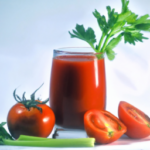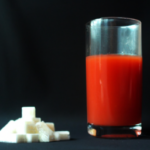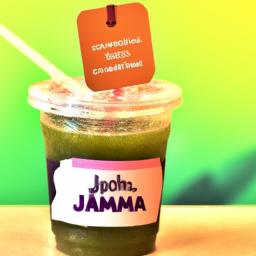As someone who prioritizes my health, I am always looking for ways to incorporate nutritious foods into my diet. Tomato juice is a great choice, packed with important vitamins and minerals that promote good health. But, it’s important to consider: what is the recommended daily intake of tomato juice for optimal health benefits?
In this article, I will explore the recommended daily intake of tomato juice, the factors that affect how much you should drink, and the potential risks of overconsumption. Tomatoes are a rich source of vitamin C, potassium, and lycopene, a powerful antioxidant that helps protect against cancer and heart disease. Drinking tomato juice is an easy way to reap these nutritional benefits, but it is important to know how much is too much.
Factors such as age, gender, weight, and activity level can all influence how much tomato juice you should consume, and it is important to strike a balance between getting enough nutrients and avoiding potential risks. In the following sections, I will delve deeper into the recommended daily intake of tomato juice, as well as the risks and benefits associated with consuming this healthy beverage.
Key Takeaways
- The recommended intake of tomato juice is 1-2 cups per day for adults, but factors such as age, gender, weight, and activity level can influence intake.
- Tomato juice is rich in vitamins and minerals, a good source of lycopene, can aid in digestion, and improve athletic performance, but overconsumption can lead to an increase in potassium levels and exacerbate acid reflux in some individuals.
- Low-sodium options should be chosen to maintain healthy blood pressure, and incorporating tomato juice into recipes can add flavor and nutrition to dishes such as soups and stews.
- When determining fluid intake, age, gender, physical activity level, and hydration needs should be considered, and moderation is key when incorporating tomato juice into the diet. Consult a healthcare provider if there are concerns.
Nutritional Benefits of Tomato Juice
Sip on some tomato juice for a quick and delicious way to boost your daily intake of essential vitamins and minerals! Tomato juice is a great source of vitamin C, which helps to strengthen the immune system and promote healthy skin.
It also contains vitamin A, which is essential for maintaining good eye health. Additionally, tomato juice is rich in potassium, which helps to regulate blood pressure and improve heart health.
Aside from its nutritional benefits, tomato juice can also aid in digestion. The high fiber content in tomato juice helps to regulate bowel movements and prevent constipation. Furthermore, the acidity in tomato juice can stimulate the release of digestive enzymes, which can help to break down food more efficiently.
With all these benefits, incorporating tomato juice into your daily diet can lead to a healthier and happier you! When it comes to the recommended daily intake of tomato juice, it is important to note that moderation is key. While tomato juice is a healthy addition to any diet, it’s important not to overdo it. Experts recommend drinking no more than one cup of tomato juice per day to reap its nutritional benefits without overloading on sugar or sodium.
Recommended Daily Intake of Tomato Juice
Indulge in the goodness of tomato juice every day for optimal health benefits. The recommended daily intake of tomato juice varies depending on your age, gender, and physical activity level. However, as a general guideline, it’s suggested that adults consume one to two cups of tomato juice per day.
Tomato juice is a great way to stay hydrated as it contains high levels of water, essential vitamins, and minerals. Additionally, it’s been found to improve athletic performance due to its ability to decrease oxidative stress and inflammation in the body. Incorporating tomato juice into your daily diet can not only improve your overall health but also enhance your physical performance.
As you can see, tomato juice has numerous benefits for your health and athletic performance. However, it’s important to consider other factors such as your age, gender, and physical activity level when determining how much tomato juice you should drink.
Factors Affecting How Much Tomato Juice You Should Drink
To determine your recommended daily intake of tomato juice, take into account your age, gender, and physical activity level. Your hydration needs also play a crucial role in deciding how much tomato juice you should drink.
In general, it’s recommended to consume 8-10 cups of fluids per day, and tomato juice can be a part of this intake. However, if you have any medical conditions such as kidney problems or high blood pressure, you should consult with your healthcare provider to determine the appropriate amount of tomato juice for you.
To keep your interest piqued, here are some factors that can affect how much tomato juice you should drink:
- Age: Older adults may require more fluids to stay hydrated.
- Gender: Men typically need more fluids than women due to their higher muscle mass.
- Physical activity level: If you’re more physically active, you may need more fluids to replenish what you lose through sweat.
It’s important to note that tomato juice contains sodium, which can be a concern for individuals with high blood pressure or other medical conditions.
Now, let’s delve into the risks of drinking too much tomato juice.
Risks of Drinking Too Much Tomato Juice
Be aware of the risks you may face if you consume an excessive amount of tomato juice. While tomato juice is a nutritious drink, overconsumption can lead to certain health concerns. One potential risk of drinking too much tomato juice is an increase in potassium levels. This is particularly concerning for individuals with kidney problems, as high levels of potassium can be harmful to the kidneys.
Another potential risk of overconsumption of tomato juice is acid reflux. Tomatoes are acidic and may exacerbate symptoms of acid reflux in some individuals. In addition, tomato juice often contains added salt, which can further aggravate acid reflux. It is important to be mindful of your intake of tomato juice and to consult with a healthcare professional if you have any concerns about its effects on your health.
When incorporating tomato juice into your diet, it is important to do so in moderation and to consider any potential health concerns.
How to Incorporate Tomato Juice into Your Diet
I’ve found that incorporating tomato juice into my diet is a great way to reap its health benefits. There are three main ways to consume tomato juice: as a beverage, in recipes, and as a salad dressing.
Drinking tomato juice as a beverage is a refreshing and healthy alternative to sugary drinks.
Adding tomato juice to recipes, such as soups or sauces, can enhance the flavor and nutritional value.
Lastly, using tomato juice as a salad dressing is a delicious way to add a tangy flavor to any salad.
As a Beverage
You’ll want to savor the refreshing taste of tomato juice as a delicious beverage, perfect for any time of day. Not only is tomato juice a great source of vitamins and minerals, but it also has a unique taste that can be enjoyed on its own or as a mixer in cocktails. When choosing a tomato juice to drink, it’s important to look for low-sodium options to maintain a healthy blood pressure.
To showcase the versatility of tomato juice as a beverage, here’s a table that lists some popular cocktails that feature tomato juice as an ingredient, along with their ingredients and instructions:
| Cocktail Name | Ingredients | Instructions |
|---|---|---|
| Bloody Mary | Tomato juice, vodka, Worcestershire sauce, hot sauce, salt, pepper | Combine all ingredients in a glass over ice and stir. Garnish with celery and a lime wedge. |
| Michelada | Tomato juice, beer, lime juice, hot sauce, Worcestershire sauce, salt, pepper | Rim a glass with chili salt. Combine all ingredients in the glass over ice and stir. Garnish with a lime wedge. |
| Red Snapper | Tomato juice, gin, lemon juice, Worcestershire sauce, hot sauce, salt, pepper | Combine all ingredients in a shaker with ice and shake until chilled. Strain into a glass over ice and garnish with a celery stalk. |
| Bloody Caesar | Tomato juice, vodka, clam juice, Worcestershire sauce, hot sauce, salt, pepper | Rim a glass with celery salt. Combine all ingredients in the glass over ice and stir. Garnish with a celery stalk and a lime wedge. |
| Virgin Mary | Tomato juice, lemon juice, Worcestershire sauce, hot sauce, salt, pepper | Combine all ingredients in a glass over ice and stir. Garnish with a celery stalk and a lime wedge. |
As you can see, tomato juice can be a tasty addition to many cocktails. But it’s important to remember that moderation is key, and to always drink responsibly. Moving on to incorporating tomato juice in recipes, there are many delicious and healthy options to explore.
In Recipes
Incorporating tomato juice into your culinary creations can elevate the flavors and add a healthy twist to your favorite dishes. Some popular ways to use tomato juice in recipes include mixing it into tomato-based soups for a richer, more flavorful broth.
It can also be added to vegetable soups or stews for an extra boost of nutrients. Tomato juice can even be used to make delicious and healthy tomato juice cocktails, such as Bloody Marys or Virgin Marys. These drinks are a great way to enjoy the taste of tomato juice while also getting the benefits of its high vitamin and antioxidant content.
So next time you’re looking for a way to add some extra flavor and nutrition to your meals, consider incorporating tomato juice into your dishes. As a salad dressing, tomato juice can also add a tangy flavor and a boost of nutrients to your greens and veggies.
As a Salad Dressing
In recipes, tomato juice is often used as a base for dishes such as soups and stews. But did you know that tomato juice can also be used as a salad dressing? It may sound unusual, but tomato juice can add a refreshing and tangy flavor to your greens.
To make a simple tomato juice salad dressing, all you need is tomato juice, olive oil, vinegar, and your preferred seasoning. Mix them together and voila! You have a healthy and delicious dressing for your salad.
Another way to enjoy tomato juice is by using it in cocktails. Bloody Mary, anyone? This classic cocktail is made with tomato juice, vodka, and various spices, making it a popular drink for brunch or happy hour.
Moving forward, let’s talk about the benefits of using tomato juice as a dressing or in cocktails compared to eating whole tomatoes. While whole tomatoes are a great source of fiber and vitamin C, drinking tomato juice can provide a more concentrated dose of nutrients. Plus, tomato juice is lower in calories and sugar compared to other fruit juices.
So, next time you make a salad or a cocktail, consider using tomato juice as a healthy and flavorful ingredient.
Tomato Juice vs. Whole Tomatoes
If you’re looking for a convenient way to consume more tomatoes, drinking tomato juice is a great option. Plus, it’s a good source of hydration and vitamins. However, it’s important to note that while tomato juice can be a healthy option, it doesn’t necessarily provide the same benefits as eating whole tomatoes.
Fresh tomatoes are a great source of vitamin C, potassium, and fiber. However, when comparing nutrient content, canned tomatoes come out on top. This is because the canning process actually increases the availability of the antioxidant lycopene, which is known for its potential cancer-fighting properties. When it comes to tomato juice, the processing removes some of the fiber and other beneficial nutrients found in whole tomatoes. Nonetheless, it still contains high levels of lycopene and vitamin C.
With that said, if you’re looking to lose weight, incorporating tomato juice into your diet can be a helpful tool.
Tomato Juice for Weight Loss
To shed some pounds, you might want to consider swapping your sugary drinks with a glass of refreshing and nutrient-rich tomato juice. Not only is tomato juice low in calories, but it’s also packed with vitamins and minerals that can help boost your metabolism and keep you hydrated.
Here are some ways tomato juice can aid in weight loss:
-
Tomato juice is a rich source of antioxidants that can help prevent inflammation in the body, which is linked to weight gain and obesity.
-
Drinking tomato juice before meals can help reduce your appetite, making you feel fuller and less likely to overeat.
-
Tomato juice is a great alternative to sugary drinks, which are known to contribute to weight gain and other health problems.
In addition to aiding in weight loss, tomato juice is also beneficial for heart health.
Tomato Juice for Heart Health
I’ve recently discovered the amazing benefits of tomato juice for heart health. Studies have shown that drinking tomato juice can lower cholesterol levels and reduce the risk of heart disease.
Additionally, tomato juice has been found to help lower blood pressure, making it a great addition to a heart-healthy diet.
Lowers Cholesterol
Lowers cholesterol levels with just a daily glass of tomato juice. Studies have shown that drinking tomato juice can reduce LDL cholesterol, also known as the ‘bad’ cholesterol, which can lead to the buildup of plaque in the arteries.
However, the benefits of tomato juice extend beyond just cholesterol reduction. It contains lycopene, a powerful antioxidant that can protect against cellular damage and inflammation. Additionally, tomato juice is a good source of potassium, which can help lower blood pressure and reduce the risk of heart disease.
Incorporating tomato juice into your diet, along with regular exercise, can have a significant impact on your overall heart health. Drinking just one glass of tomato juice a day can help reduce your cholesterol levels and protect against the development of heart disease.
So, if you’re looking for a simple and effective way to improve your heart health, consider adding tomato juice to your daily routine.
Reduces Risk of Heart Disease
You can significantly reduce your risk of heart disease by incorporating a daily glass of tomato juice into your diet. Tomato juice is a great source of lycopene, a powerful antioxidant that helps prevent the oxidation of LDL cholesterol, which is a major contributor to heart disease.
Here are some preventive benefits of drinking tomato juice:
- Reduces inflammation in the body
- Lowers blood pressure
- Improves blood vessel function
- Reduces the risk of blood clots
In addition to drinking tomato juice, making lifestyle changes such as exercising regularly, maintaining a healthy weight, and reducing stress can also help prevent heart disease. By incorporating these changes into your daily routine, you can significantly reduce your risk of heart disease and improve your overall health.
It’s important to note that tomato juice not only reduces the risk of heart disease but also lowers blood pressure.
Lowers Blood Pressure
Feeling stressed? Incorporating tomato juice into your diet may help lower your blood pressure and improve your overall health. Studies have shown that drinking tomato juice regularly can have significant effects on blood pressure. This is because tomatoes are rich in potassium, a mineral that helps to regulate blood pressure by counteracting the effects of sodium. In fact, a cup of tomato juice contains about 500mg of potassium, which is roughly 10% of the recommended daily intake.
But the benefits of tomato juice don’t stop there. Research has also shown that tomato juice can have positive effects on kidney function. This is because it contains compounds that help to prevent the formation of kidney stones and improve the overall health of the kidneys. While alternative remedies for high blood pressure and kidney problems exist, incorporating tomato juice into your diet is a simple and effective way to improve your health. In the next section, we’ll explore how tomato juice can benefit your skin health.
Tomato Juice for Skin Health
If you’re looking to give your skin a healthy glow, sipping on a glass of tomato juice a day can work wonders. Tomato juice is packed with antioxidants that protect your skin from damage caused by free radicals. These antioxidants help to reduce inflammation and prevent premature aging, keeping your skin looking young and fresh.
Tomato juice can also help to improve the texture of your skin, thanks to its high vitamin C content. Vitamin C is essential for the production of collagen, which is a protein that gives your skin its elasticity. Drinking tomato juice regularly can help to boost collagen production, giving you smoother, firmer skin.
So, if you’re looking for a natural way to improve your skin health, try incorporating tomato juice into your daily routine.
Frequently Asked Questions
Can tomato juice be substituted for whole tomatoes in recipes?
Yes, tomato juice can be substituted for whole tomatoes in recipes. Use one cup of tomato juice for every two medium-sized tomatoes. Tomato juice can also be used in a variety of recipes, including soups, stews, and sauces. Enjoy!
Does the nutritional value of tomato juice change if it is freshly squeezed or store-bought?
Freshly squeezed tomato juice has higher nutritional value than store-bought due to processing methods. Antioxidants and vitamins are lost in processing. Juxtaposing the two types creates a vivid image of the differences.
Can drinking too much tomato juice cause kidney stones?
Drinking excessive amounts of tomato juice may increase the risk of kidney stones due to its high concentration of oxalates. However, moderate consumption can contribute to hydration and overall health benefits.
Should pregnant women avoid drinking tomato juice?
As a pregnant woman, I should be cautious when consuming tomato juice. While it is generally safe, excessive intake can increase the risk of gestational diabetes. Additionally, I should limit my intake during breastfeeding to avoid potential digestive issues for my baby.
Is it safe to mix tomato juice with alcohol?
Mixing tomato juice and alcohol can increase the potential health risks, but moderate consumption with safety precautions can be safe. Evidence-based research highlights the importance of understanding the effects of alcohol on the body when consuming tomato juice.
Conclusion
Overall, incorporating tomato juice into your diet can provide a range of nutritional benefits, such as promoting heart and skin health, as well as aiding in weight loss. It’s important to keep in mind that the recommended daily intake of tomato juice is around one to two cups per day. However, individual factors such as age, gender, and health conditions can impact how much tomato juice you should consume.
As with any food or drink, moderation is key to avoiding potential risks and negative side effects. So, are you ready to start reaping the benefits of tomato juice? Consider incorporating it into your daily routine by drinking a glass in the morning or using it as a base for a healthy smoothie. Remember to listen to your body and adjust your intake accordingly.
With its numerous health benefits and versatility in the kitchen, tomato juice is a nutritious addition to any diet.
Ilana has been a vegan for over 10 years. She originally made the switch for health reasons, but soon found herself becoming more and more passionate about the ethical and environmental implications of a vegan lifestyle. Ilana is the author of The Graceful Kitchen, a blog all about veganism. She loves to cook up delicious and nutritious vegan meals, and share her recipes with others who are interested in leading a cruelty-free life. Ilana is also a strong advocate for using whole foods as the foundation of a healthy diet, and believes that going vegan is one of the best ways to achieve this.
















